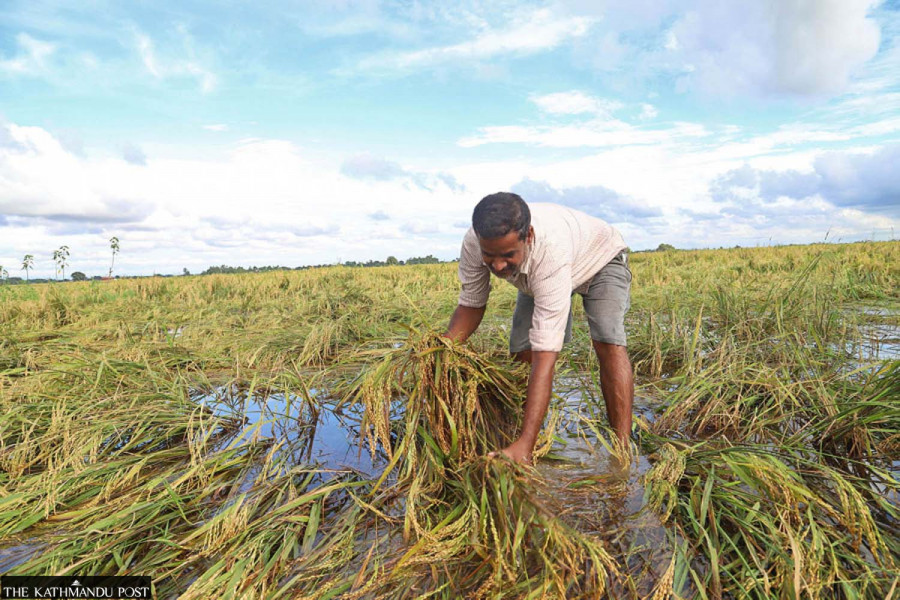
On Thursday, Bikram Tiwari, a resident of Narainapur Rural Municipality-6 in Banke district, bought a 50-kg sack of rice with the relief money provided by the Nepal Red Cross Society.
The 54-year-old farmer said it was the first time in his life that he bought rice.
“All the grains stored in my house have been damaged by floodwaters,” Tiwari said over the phone from Narainapur. “Due to a dry spell in the monsoon season, we could not cultivate all the arable land and now floodwaters damaged not only ready-to-harvest crops but also the foodstuffs stored in the house.”
Narainapur, a remote municipality in western Nepal, was declared a drought-hit zone due to a dry spell in mid-monsoon season that either deprived farmers of cultivation or caused saplings to wither in the fields.
The district authorities had declared Narainapur as drought-hit area in August.
Thousands of people from the rural municipality, one of the worst-hit areas when the pandemic gripped the country in the spring of 2020, migrated to India in search of work due to problems with agriculture caused by the climatic condition.
The weather varies greatly in Nepal. Low rainfall is not the only problem. Excessive rainfall causes havoc too. Last year, the freak rain post-monsoon inundated farmlands in 3,966 hectares.
The government has failed to take necessary measures to protect the farmers from erratic weather. Narainapur has no access to irrigation and farmers there depend on rainfall for agriculture. Given the extended dry spell in the areas this year, paddy fields have developed cracks and the crops are drying up.
Officials at Narainapur Rural Municipality said owing to the drought this year, only 15 percent of the total arable land in the area was cultivated. “Almost all places of the municipality have been inundated by floods triggered by persistent rainfall for five days,” said Laxmi Kanta Mishra, spokesperson for the municipal office. “We have started collecting data on the loss incurred by farmers.”
The local unit had collected such data after declaring the area drought-hit zone in monsoon, but the affected farmers have received no help so far.
Increasingly, Nepal has found itself at the receiving end of the climate crisis. Drought and dry spells in the cultivation season and floods and inundation in the harvesting season have become a new normal in the country over the past few years.
“Droughts, dry spells, flooding, and inundation not only affect any particular sector like food security,” said Raju Pandit Chhetri, director of Prakriti Resources Centre, which advocates environment-friendly policies and development practices. “Implications of climate change will be in multiple sectors—health, food security, education and women empowerment, among others.”
At least 119 people have died, 38 are missing, and 107 people were injured in disaster-related incidents during this monsoon. According to the National Disaster Risk Reduction and Management Authority, 5,465 people have been relocated, 273 houses were destroyed and 78 were partially damaged by floods and landslides.
Scores of studies and scientific analyses over the decade and, more recently, the IPCC report, have warned that Nepal is one of the most vulnerable countries to the climate crisis and business-as-usual approach isn’t sufficient to tackle the adverse impacts of the crisis.
As climate disasters fuelled by erratic weather patterns become more pronounced and frequent, experts say several other crises have been in the making over the years including climate displacement, both internal and external.
“First of all, farmers should be provided with scientific information about weather patterns. For that, authorities should strengthen early warning and weather monitoring systems,” said Chhetri. “They should be provided drought and flood-resistant crops, or other alternatives of food crops, and insurance.”
Experts warn that the impacts of global warming will be both short-term and long-term and across multiple sectors.
“I am worried about how to feed my family,” said Tiwari, the head of a nine-member family. “We somehow managed to cultivate five kattha (18,225 square feet) of land by using borewell water but the floods have damaged the crops.”












